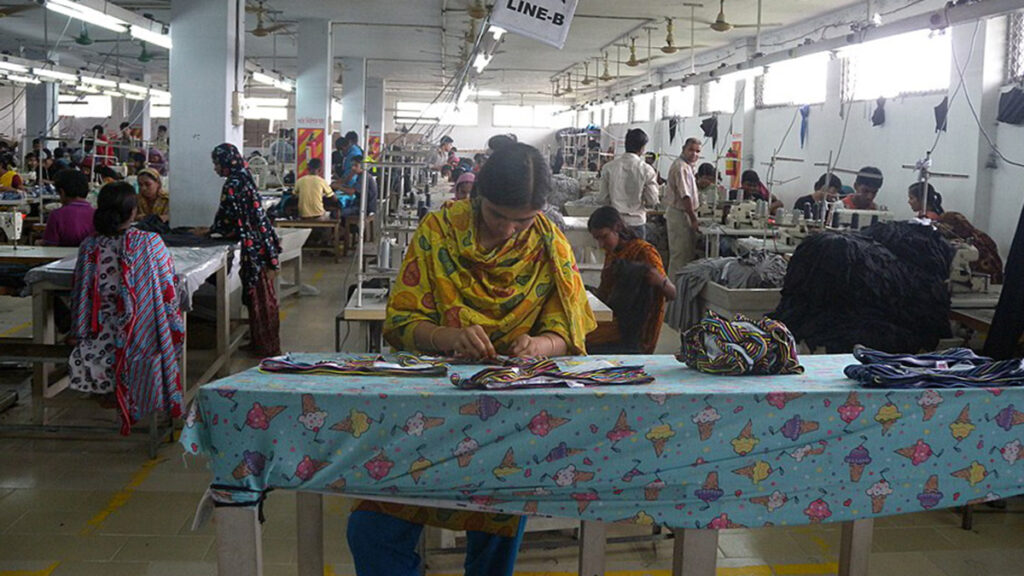

More than 75 million people work in the garment industry, many of them in the world’s hottest countries. As climate change warms the air and oceans, so too does it seep into the stuffy chambers of garment factories, where conditions are highly uncomfortable if not downright unsafe.
In research recently published in The Lancet, scientists tested different interventions for protecting workers from rising temperatures in Bangladesh, a nation where 80% of its export revenue comes from the garment industry. The 4 million Bangladeshi people, mostly women, who sew ready-made garments often work 12-hour shifts 6 days a week in humid and poorly ventilated buildings. Prolonged heat stress can put strain on their cardiovascular systems and increase their risk of heat stroke, especially because many workers have existing kidney and cardiovascular issues.
“I think it’s really important that we get ahead of the curve and start identifying solutions…that are both effective in today’s climate, but also future-proof.”
“Bangladesh has already been identified as one of the most climate-change-vulnerable countries in the world,” said lead author James Smallcombe, a thermal physiologist at the University of Sydney. “I think it’s really important that we get ahead of the curve and start identifying solutions…that are both effective in today’s climate, but also future-proof.”
His team began by outfitting a factory in Bangladesh with temperature and humidity sensors to determine hot spots that might respond to building-level changes. They then re-created the factory conditions inside a climate-controlled chamber, where volunteer participants conducted factory work while having their physical health and productivity assessed.
Here are the most promising solutions from the study.
1. Green and White Roofs
Most factory roofs in Bangladesh are made of hard concrete or sheet metal, both of which trap heat.
Friendlier “green” roofs require planting a layer of vegetation on top, and “white” roofs involve applying a layer of reflective white paint. While white roofs are cheap to retrofit, green roofs require more installation and maintenance costs—resources that, in turn, contribute to enhancing biodiversity and storing carbon.
Factory owners are often reluctant to make such capital investments, especially in an era of tariffs and economic uncertainty. If they do, however, such building-level changes can lower indoor heat by a dramatic 2°C–3°C (3.6°F–5.4°F) and reduce individuals’ core temperature, heart rate, and level of dehydration.
2. Electric Fans
While air conditioners (ACs) are nearly ubiquitous in the United States, they are hardly a global panacea due to their high costs and energy demands. Electric fans may solve both of ACs’ ills, but they improved only physical comfort in the study, not physiological strain.
Using fans as cooling devices can be deceptively tricky, explained environmental physiologist George Havenith of Loughborough University, United Kingdom: At temperatures above 43°C (109°F), fans push heat onto the skin more than they help evaporate sweat.
Havenith, who was not a part of the new study, noted that fans with a water spray function can also cool the body, as can combining normal fans with wet clothing—known as the “wet T-shirt method” of alleviating heat stress. A major benefit of fans is that they can direct airflow to particularly vulnerable areas of a factory, such as stations where ironing and steaming create extra heat.
3. Water Breaks
One of the best ways to cool the body is from the inside out. Researchers found that taking a water break once or twice an hour lowered participants’ core temperatures, heart rate, level of dehydration, and discomfort when paired with an electric fan.
However, noted Vidhya Venugopal, an occupational and environmental health researcher at the Sri Ramachandra Institute of Higher Education and Research in Chennai, India, garment workers are typically paid at a per-piece rate, making them reluctant to take breaks and receive less income. Even if employers distributed water to each station, she said, many factories lack bathroom facilities, meaning workers would have nowhere to relieve themselves. Venugopal was not involved in the new research.
“We have the scientific evidence to prove that these things can work. The main challenge is, How do we get them into a policy framework?”
Notably, the break helps more if it’s in a cooler location, said Dung Phung, a public health scientist at the University of Queensland who was not involved in the study. His own research in Thailand showed that lumber workers’ health improved after taking breaks under trees or in a cool house.
Ultimately, said study coauthor Fahim Tonmoy, a climate change adaptation researcher at Griffith University in Australia, “we have the scientific evidence to prove that these things can work. The main challenge is, How do we get them into a policy framework?”
The team hopes their findings on productivity may move the needle; unmediated heat stress lowered workers’ efficiency so much that even taking breaks improved their output. Tonmoy also said clothing companies can create incentives by buying only from factories that implement such solutions.
As temperatures in Southeast Asia “get hotter by the day,” said Venugopal, making changes will only become more vital. “We are not talking about a few people,” she said. “We are talking about millions and millions.”
—Hannah Richter (@hannah-richter.bsky.social), Science Writer
Citation: Richter, H. (2025), Garment factories are heating up. Here’s how workers can stay cool, Eos, 106, https://doi.org/10.1029/2025EO250425. Published on 14 November 2025.
Text © 2025. The authors. CC BY-NC-ND 3.0
Except where otherwise noted, images are subject to copyright. Any reuse without express permission from the copyright owner is prohibited.


